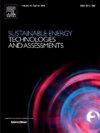通过频率相关的交流偏置波形优化,增强高效PERC、TOPCon和HIT晶体硅太阳能电池的LeTID缓解和再生
IF 7
2区 工程技术
Q1 ENERGY & FUELS
Sustainable Energy Technologies and Assessments
Pub Date : 2025-07-18
DOI:10.1016/j.seta.2025.104446
引用次数: 0
摘要
LeTID显著影响c-Si太阳能电池的性能,特别是在PERC、TOPCon和HIT技术中。本研究研究了这些太阳能电池在85°C的1次太阳照射下11小时的降解和随后的再生,然后使用正弦、方形和三角形波形在500 kHz下进行2小时的交流偏置。降解结果表明,PERC电池的性能损失最大,Jsc、Voc、FF和η分别下降了4.56%、5.03%、4.15%和4.18%。TOPCon细胞的降解程度适中,分别减少了3.33%、4.56%、3.98%和3.92%,而HIT细胞的降解程度最低,分别减少了1.84%、1.76%、1.74%和1.64%。再生分析表明,方波交流偏置是最有效的,在TOPCon中恢复99.73%的效率,在HIT中恢复99.54%,在PERC中恢复96.78%。方波交流偏置的优越性能归因于其尖锐的电压跃迁,增强了载流子重分布和缺陷钝化。正弦波表现出适度的恢复,而三角形波形效果最差。研究结果表明,TOPCon是对基于交流偏置的LeTID缓解最敏感的技术,而PERC仍然是最容易受到钝化不稳定性和复合损失影响的技术。这些结果突出了方波交流偏置作为一种有前途的技术,可以提高c-Si太阳能电池在长期野外作业中的稳定性和效率。本文章由计算机程序翻译,如有差异,请以英文原文为准。
Enhancing LeTID mitigation and regeneration in High-Efficiency PERC, TOPCon, and HIT crystalline silicon solar cells through Frequency-Dependent AC biasing waveform optimization
LeTID significantly impacts the performance of c-Si solar cells, particularly in PERC, TOPCon, and HIT technologies. This study investigates these solar cells’ degradation and subsequent regeneration under 1-sun illumination at 85 °C for 11 h, followed by 2-hour AC biasing at 500 kHz using sinusoidal, square, and triangular waveforms. The degradation results indicate that PERC cells exhibit the highest performance loss, with Jsc, Voc, FF, and η declining by approximately 4.56 %, 5.03 %, 4.15 %, and 4.18 %. TOPCon cells moderate degradation with reductions of 3.33 %, 4.56 %, 3.98 %, and 3.92 %, while HIT cells exhibit the least degradation, with losses of only 1.84 %, 1.76 %, 1.74 %, and 1.64 %. Regeneration analysis reveals that square waveform AC biasing is the most effective, restoring 99.73 % of efficiency in TOPCon, 99.54 % in HIT, and 96.78 % in PERC. The superior performance of square waveform AC biasing is attributed to its sharp voltage transitions, which enhance charge carrier redistribution and defect passivation. Sinusoidal waveforms demonstrate moderate recovery, while triangular waveforms are the least effective. The findings establish TOPCon as the most responsive technology to AC biasing-based LeTID mitigation, while PERC remains the most vulnerable due to passivation instability and recombination losses. These results highlight square waveform AC biasing as a promising technique for improving the stability and efficiency of c-Si solar cells in long-term field operations.
求助全文
通过发布文献求助,成功后即可免费获取论文全文。
去求助
来源期刊

Sustainable Energy Technologies and Assessments
Energy-Renewable Energy, Sustainability and the Environment
CiteScore
12.70
自引率
12.50%
发文量
1091
期刊介绍:
Encouraging a transition to a sustainable energy future is imperative for our world. Technologies that enable this shift in various sectors like transportation, heating, and power systems are of utmost importance. Sustainable Energy Technologies and Assessments welcomes papers focusing on a range of aspects and levels of technological advancements in energy generation and utilization. The aim is to reduce the negative environmental impact associated with energy production and consumption, spanning from laboratory experiments to real-world applications in the commercial sector.
 求助内容:
求助内容: 应助结果提醒方式:
应助结果提醒方式:


